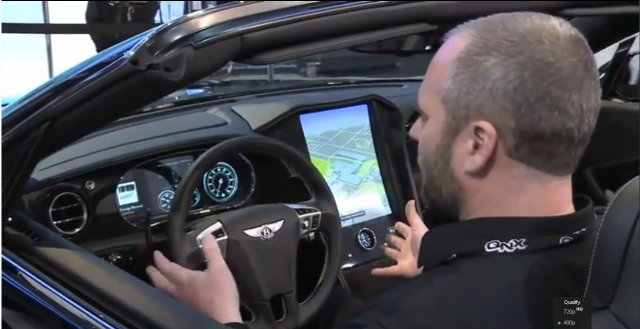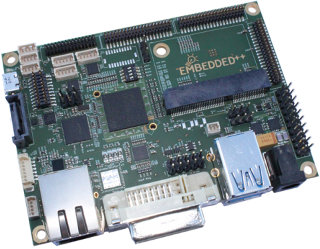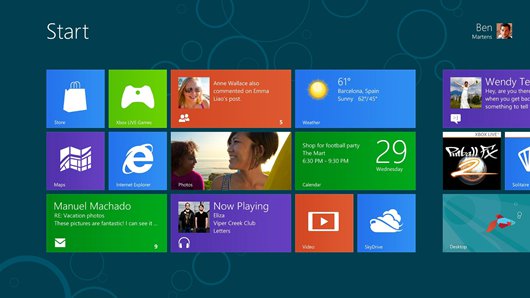I’m always very confused when it comes to comparing GPUs in different SoCs, and I could not really find comparisons on the web, so I’m going to give it a try even though, as you’re going to find out, it’s actually quite a challenge. There are mainly 4 companies that provide GPUs: ARM, Imagination Technologies, Vivante and Nvidia. [Update: Two comments mentioned Qualcomm Adreno and Broadcom VideoCore are missing from the list. Maybe I’ll do an update later]. Each company offers many different versions and flavors of their GPU as summarized below. ARM Imagination Technologies Vivante Nvidia Mali-400 Series: Mali-400 MP Mali-450 MP Mali-600 Series Mali-T604 Mali-T624 Mali-T628 Mali-T658 Mali-T678 PowerVR SGX Series 5: SGX520 SGX530 SGX531 SGX535 SGX540 SGX545 PowerVR SGX Series 5XT: SGX543MP1-16 SGX544MP1-16 SGX554MP1-16 PowerVR SGX Series 6: G6200 G6230 G6400 G6430 G6600 2D graphics: GC300 GC350 3D graphics: GC400 GC800 GC1000 GC2000 GC4000 ULP GeForce (Tegra […]
QNX CAR 2.0 Demo and Texas Instruments OMAP5 Jacinto 6 Processor
There’s a Bentley GT concept car at CES 2012 to demonstrate QNX CAR 2.0 platform that provides dual screen support with the dashboard and an infotainment display for the automotive industry. Under the hood, the platform features TI DLP technology, and TI OMAP5 and Jacinto processors running QNX Neutrino RTOS. Texas Instruments and QNX uploaded a video demo of the concept on YouTube. They explain that they switched their platform from HTML5 to native OpenGL for optimal performance using Storyboard Suite from Crank software, and they can now show 3D maps smoothly on the platform. The 1080p user display is curved to be more user friendly (better touch angles). You must have certainly heard about touchscreens before, but maybe never heard about “pretouch”. Pretouch is a feature of the system that detect when you hand comes close to a control virtual and pops up a virtual menu. The dashboard shows […]
ISEE is Working on IGEPv5 Board with TI OMAP 5 and Needs Your Feedback
ISEE IGEPv2 is a low cost development board based on TI DM3730 (Cortex A8) that is relatively popular with the development community, used by Free Electrons for their embedded Linux training courses, and part of a List of 39 Low Cost Linux Friendly Boards and Products I published earlier this year. Yesterday, Michael Opdenacker, founder of Free Electrons, wrote a blog post saying ISEE was working on IGEPv5 development board based on Texas Instruments OMAP5 dual core Cortex A15 processor that can run up to 2 GHz, supports DDR3 RAM, full HD 3D recording, and 4 displays and cameras simultaneously among other things. This is still early development and the board exact features have not been defined yet. ISEE is actually looking for the community feedback to provide the best board possible and you can leave your inputs and expectations by commenting on Free Electrons blog. You could have a […]
Texas Instruments OMAP 5 Cortex A15 Systems-on-Module Galore
Today Texas Instruments published a press release to announce partners 6 company had worked to design and manufactures systems-on-module based on the dual core Cortex A15 OMAP 5 SoC and that those would be on display at Electronica Trade Faire this week (13-16 October) in Munich. Embedded++ EPP-Pico-OMAP5430 This solution is actually a Pico-ITX board based on OMAP5430 with 2 GB LP-DDR2, USB 3.0 SuperSpeed connectivity (1x USB 3.0, 3x USB 2.0), up to 16 GB eMMC storage, a SATA port, a 100Mb Ethernet port , UART, RS-323 & SPI ports, GPIOs, DVI and LVDS outputs, a serial camera input port, a micro SD card socket, Murata WiLink 8.0 connectivity solution (Wi-Fi, GNSS, Bluetooth®, Bluetooth v4.0 and FM technologies) and a built-in battery charger (1-cell Li-Ion). The company provides Linux and Android 4.1 BSP. Check the product page for a few more details. GreenBase GK-5432 GK-5432 is a computer on […]
Texas Instruments Unveils Wi-Fi CERTIFIED Miracast Video Streaming Solution Based on OMAP 4
In my previous post, I wrote about Marvell announcement of its new 802.11ac chipset (Avastar 88W8897) that will be Wi-Fi CERTIFIED Miracast. But it’s not the only company for such solution, as Texas Instruments has also announced the availability of a complete solution for mobile devices designed to support Wi-Fi CERTIFIED Miracast, based on the Wi-Fi Alliance Wi-Fi Display Specification that enables users to reliably display high definition content from a mobile device onto a larger screen over a secure, low-latency, wireless network connection. The Miracast certification program defines a standards-based solution for streaming video and audio content over a peer-to-peer Wi-Fi Direct wireless network. TI solutions will leverage OMAP processors and its WiLink connectivity solutions to provide a Miracast platform. This new solution will be available later this year to power mobile phones, tablets, HDTVs, projectors and audio receivers. Texas Instruments solution will provide the hardware and software resources […]
Texas Instruments Showcases OMAP 5 GPU Capabilities with GLBenchmark 2.5
In February, Texas Instruments compared the browser rendering performance of its OMAP 5 platform to the Nvidia Tegra 3, and the benchmark results showed OMAP 5 was twice as fast @ 800 MHz than the Tegra 3 @ 1.3 GHz. Today, they’ve uploaded a video showing the 3D performance a tablet based on OMAP 5 (and PowerVR SGX 544-MP GPU) against a market-leading tablet (I guess it’s the Apple iPad 3 with PowerVR SGX 543 GPU) using GLBenchmark 2.5 with the following setup: 1080p resolution. On-screen and off-screen tests were conducted to compensate for the “Vysnc Limited” scenarios. (24bpp) 16bit depth tests to better represent high-end game content Power saving mode disabled and device connected to a power source. No background tasks and airplane mode “on.” The on-screen results show 38 fps for the OMAP 5 vs 34 fps for the other platform, or a 12% performance boost. Off-screen results […]
Linaro 12.03 Release with Kernel 3.3-rc3
Linaro has just released version 12.03 based on Linux Kernel 3.3-rc3 and Android 4.0.3. Among the key points, hardware video decode in now supported in Origen (Android), Android runs in A15/A7 platforms, libav AAC optimization provides about 2x performance improvement and QEMU supports Samsung Exynos 4240 and Calxeda Highbank (work done upstream). Here are the highlights of the release: Android Linaro Android has support for DS-5 version 5.9. Hardware accelerated Multimedia is now integrated on Origen. EEMBC, denbench and coremark have been ported to Android and are running in LAVA. android.net ConnectivityManager unit tests have been built and integrated in all builds. Hardware decode of H264 and MPEG4, 1080P and 30 FPS is enabled on Origen. Origen now has 1080p HDMI Graphics and Video Support. Android runs on A15, A7 and A15/A7 fast models. ARM’s big.LITTLE has been tested running Android using a set of unit tests. Kernels of prebuilt […]
Microsoft Unveils Windows 8 Consumer Preview at MWC 2012
Earlier this month, Microsoft announced they would be releasing Windows 8 Consumer Preview at the end of February, and they have done so yesterday with an official announcement at Mobile World Congress 2012, in Barcelona, Spain. During the event, they showcased ARM tablets based on Nvidia Tegra 3, Qualcomm Snapdragon S4 and Texas Instruments OMAP 4/5, as well as tablets, ultrabooks, laptops and touch PCs based on Intel meldfield and clove trail. All those devices are reference platform for developers and not actual products although Microsoft expect manufacturers to use those reference designs to build their products. The Touch PC used a an interesting screen which could be positioned vertically (like a normal screen). horizontally (like a surface PC) and at an angle for use cases such as an architecture reading a plan or an artist drawing a painting. They also showcased a very large touchscreen that could be used by […]







